AFTER THE TSUNAMI
Annam Manthiram
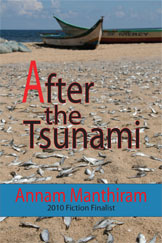
978-1-936205-43-1
In Manthiram's After the Tsunami, Siddhartha, appears to have it all: a successful career as a schoolteacher in the United States, a perceptive wife, and a son and daughter who respect him as much as they adore him. However, Siddhartha's past haunts him as he cannot help but relive the brutal and fearful events he faced as a child in an Indian orphanage. Despite his achievement and the physical distance he has put between himself and the harrowing events of his youth, those events persist and impose themselves upon his life.At the age of nine, Siddhartha loses his family to a tsunami and is taken in by a boys' home, run entirely by "Mothers" who are physically and emotionally abusive. Siddhartha alternates between describing the traumatic conditions of his confinement as a child and his seemingly carefree life in America. Only when his daughter, engaged to an Indian man, asks Siddhartha to return to his homeland is he driven to confront his childhood. Siddhartha knows that he must visit the orphanage one last time. He must return to the place of his youth's destruction to let go of his past or be lost in self-torture forever.Cutting in its clarity and profoundly insightful, After the Tsunami constructs an astute landscape of friendship despite depravity, compassion amidst horror, resiliency above misfortune. This is a powerful first novel of survival and redemption. After the Tsunami will haunt and move readers everywhere.
ANNAM MANTHIRAM is also the author of the Dysfunction: Stories, which was a Finalist in the 2010 Elixir Press Fiction Award. Annam's work has been published in over twenty literary journals, including Cream City Review, Sierra Nevada Review,,and Monkeybicycle. A graduate of the M.A. Writing program at the University of Southern California, Ms. Manthiram resides in New Mexico.
AS GOOD AS MANGO
Anand Prahlad
.jpg)
978-1-936205-35-1
As Good as Mango is a journey told in the sensual language of blues and jazz. It moves from the landscape of colonial Africa into the colonial American South, and into the present. The hauntings of the past come alive with echoes of unclaimed history.The poems in this collection simultaneously affirm and inspect black identity - and identity in general. These are the poems of the bitter/sweet taste on the tongues of exiles searching for home.Recipient of the 2010 William T. Kemper Fellowship for Teaching Excellence, ANAND PRAHLAD is the author of Hear My Story and Other Poems. He has published critical studies on Black folklore, including Reggae Wisdom: Proverbs in Jamaican Music. He teaches folklore, film, and poetry at the University of Missouri, Columbia.
BACK THEN AGAIN: Simple Pleasures and Everyday Heroes
Archie P. McDonald
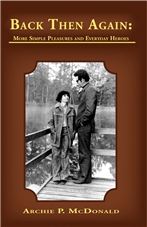
978-1-936205-06-6
Red River Radio, an affiliate of National Public Radio, headquartered in Shreveport, Louisiana, supplements their broadcast of the Morning Edition for five minutes each Friday at 7:35 a.m. for "The comments of our own Dr. Archie McDonald."Broadcast to large portions of Louisiana, Arkansas, Oklahoma, and East Texas, McDonald's comments are memories of growing up in the South of the 1940s and 1950s, his collegiate and grad school activities during the 1960s, and other miscellaneous adventures that have ushered him into the 21st Century. But, a broadcast takes a few minutes and then disappears. The printed page-McDonald's natural habitat-lasts longer. So here we are with a bit of permanence, Back Then Again: More Simple Pleasures and Everyday Heroes.
ARCHIE P. MCDONALD is the author or editor of more than forty books and monographs. He lives in Nacogdoches, Texas, where he is a Regent's Professor of History and Community Liaison at Stephen F. Austin State University, and a weekly commentator on Red River Radio.
CONDITIONS OF GRACE: New and Selected Poems
Mark Sanders

978-1-936205-16-5
Mark Sanders' Conditions of Grace: New and Selected Poems brings together the best work from a thirty-year career. These selections include powerful lyrics and narratives, metaphorical and fearless observations of the landscapes of region and heart, and a music that is at both subtle and alluring."Mark Sanders writes, he says, in "plain speech for a plain people." But the complexities of his social and familial involvements, his awareness of self and others, mean that the lives rendered here are anything but plain. They are ornery, funny, bedeviled, passionate, private, and performative-I mean, the people and Sanders' poems. This poet is of the same important tribe as Ted Kooser and Jo McDougall, Dave Etter and Jim Barnes, in tune with a type of Midwestern and democratic rhetoric-'plain' but dramatic, public but precise."-David Baker, editor of Kenyon Review
"Mark Sanders is a keen observer, a careful translator of experience and an archivist of the actual. He can 'turn sharp on a country thought' or channel Wallace Stevens, and his Conditions of Grace displays and utters a vital world of hawks, horses and humane humans either wrestling with sorrow or 'downing shots of Comfort.' His poems are deft and significant, and I'm betting most readers who find their way to this book will not be eager to find their way out. Instead, they'll want to join Sanders as, 'We stand our furious ground.'"-R. T. Smith, editor of Shenandoah.
MARK SANDERS is a Plains native-born, raised, and educated in Nebraska. His poems, stories, and creative essays have appeared in publications in the United States, Great Britain, Australia, and Canada, including Glimmer Train, Puerto Del Sol, Dalhousie Review, Prairie Schooner, Western American Literature, Ninth Letter, Shenandoah, and numerous others. Since 1977, he has authored a dozen or so chapbooks of poetry and prose, a collection of short fiction, and three collections of poetry. He has been nominated for Pushcart Prizes and received a notable mention in the 2009 Pushcart Anthology for a essay that appeared in Shenandoah; he also received acknowledgment as having written one of the 100 outstanding stories in 2007 in Best American Short Stories, edited by Stephen King. Also in 2007, he received the Mildred Bennett Award from the Nebraska Center for the Book for fostering Nebraska's literary heritage. He has taught in colleges and universities in Nebraska, Missouri, Oklahoma, Texas, and Idaho.
CONTEMPORARY ART MUSIC IN TEXAS
Edited by Stephen Lias
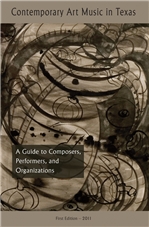
978-1-936205-15-8
With a population of close to 25 million and a size greater than many independent countries, Texas is home to an incredible variety of vibrant musical communities. Contemporary art music flourishes in disciplines ranging from experimentalism to concert music to film-scoring. While cataloguing the full extent of composing and performing in this diverse landscape would be a near-impossible task, it is our hope that this volume (and others that will follow) will begin to fill the conspicuous gap in the materials currently available.Our decision to focus this first edition on thirty representative composers, along with some organizations and academic degree programs, was simply a result of needing a practical and achievable place to start. Texas is home to world-class symphonies, opera and ballet companies, performing venues, and countless other performers and ensembles that regularly feature new works. We hope that future editions will allow us to expand to include these things, as well as additional information such as recordings available and competitions within the state.
DOCUMENTATION OF ASSOCIATED AND UNASSOCIATED CADDO FUNERARY OBJECTS
Timothy K. Perttula
.jpg)
978-1-936205-02-8
Documentation of Associated and Unassociated Caddo Funerary Objects by Timothy K. Pertulla, et al., presents the documentation and study of Native American Graves Protection and Repatriation Act (NAGPRA) funerary objects from prehistoric sites in the collections at Stephen F. Austin State University in Nacogdoches, Texas. The study arose from the 2006 concern that SFA was going to lose its anthropology program and its archeological repository. This concern brought Texas archeologists together to determine what might be done to keep the programs viable and to preserve Caddo articles in SFA's collection. The result, ultimately, was a continuing partnership between archeologists, the Caddo Nation, the university, and permanent faculty hired to maintain and study the Caddo collection. Documentation is the record of the completed NAGPRA inventories of funerary objects in the SFA collection, which were discovered at five known and recorded sites in northeastern and East Texas. The book documents and describes a number of ceramic vessels in the collection and characterizes vessel type and decoration as found at the burial sites. Among the book's features are maps of burial mound sites and illustrations of funerary objects found there. More than 100 colored photographs of funerary objects and artifacts illustrate the text; accompanying tables and appendixes detail these items.
TIMOTHY K. PERTTULA is the Manager of Archeological & Environmental Consultants, LLC (Austin, Texas), a Cultural Resources Management firm. He has a PhD from the University of Washington (1989) and has pursued research on Caddo archaeology and ethnohistory for more than 30 years.
THE EDGE OF LIFE: Forest Pathology Art
Dave Kulhavy & Michelle Rozic
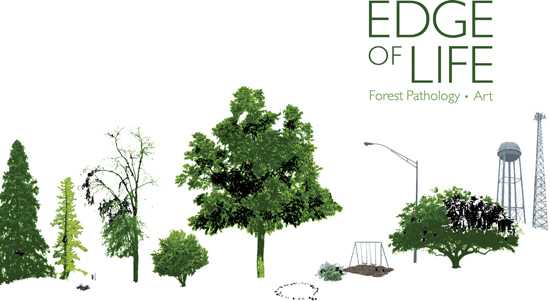
978-1-936205-31-8
The concept behind The Edge of Life began with a simple observation by Dr. David Kulhavy, who perceived the delight artists experienced when they were introduced to the Forest Pathology lab in the Arthur Temple College of Forestry and Agriculture at SFASU. They were intrigued not only by the forms of the pathogens, but also how the pathogens affect their hosts and are influenced by their environment. When Dr. Kulhavy shared his observations with the university's art faculty, and in particular with Michelle Rozic, whose recent work incorporates ecological ideas, the concept of a collaborative art and science, The Edge of Life took root.The arts and sciences are linked in a long, interdependent tradition. Art delves into humanity's internal questions about our understanding of our place within nature. Science delves into the external mechanics of nature in search of similar knowledge and understanding of these problems. Art imaginatively makes visible intangible ideas by placing abstract concepts into concrete form. Forest pathology makes evident forest diseases through identifying signs and symptoms of forest pathogens.
The Edge of Life pairs art work and specimen and provides the catalyst for discussion regarding how pathogens and invasive species affect the health of our forests, and how artists communicate concerns about contemporary ecological issues, translating their ideas through their media. Pathogens and invasive species have an inherent allure. The forms can be beautiful and repulsive, elegant in simplicity and complexity. Awareness of pathogens leads to understanding their mechanics, which develops cognizance on how our actions affect global, natural health. Forest pathologists study the unseen microscopic diseases through the visible symptoms-such as shelf fungi, known as conks or sporophores-learning to read the health of a forest ecosystem through the health of individual trees. The disease triangle illustrates the intrinsically linked co-dependency of Host-Pathogen-Environment. Pathogens transfer between and depend on host/s for survival and reproduction. Environment enables rapid spread of pathogens. Transference of pathogens is fertile ground for lessons of human behavior through artistically illuminated metaphor.
MICHELLE ROZIC has exhibited her artwork throughout the U.S. and abroad.
DAVID KULHAVY received the Distinguished Teaching Award in Entomology from the Entomological Society of America in 1993 and has been awarded the regional National Association of Interpretation award for his interpretations of Dr. Dave's Bugs.
FIELD THEORY
Meredith Trede
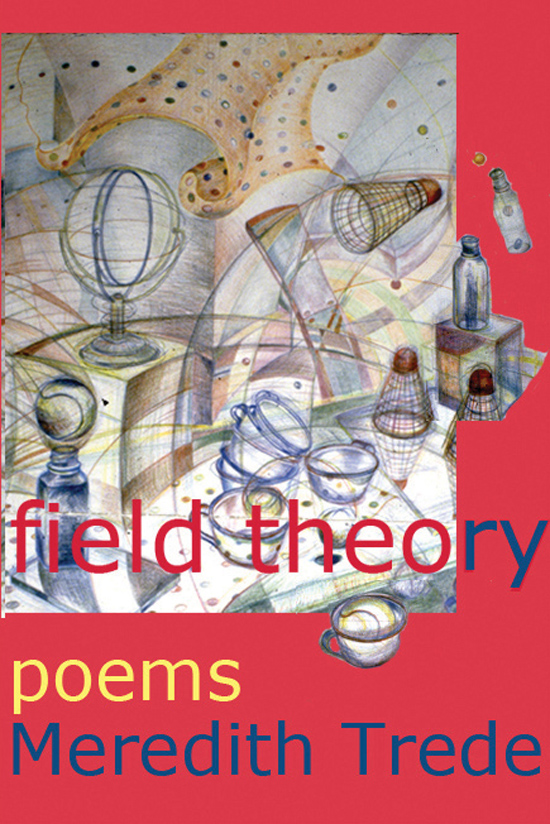
978-1-936205-37-0
With solemnity and sometimes humor, but always with grace, Ms Trede will transport you. She takes you through time, using her coming of age in New York City as a central viewing point for shifts in American culture, from post-World War II, across the Age of Aquarius to, and past, September 11, 2001. She explores the world, not in the abstract, but in precise and vivid language about loving friendships, joyful and sad recollections about family, meditations on marriage, and so much more.
According to poet Jean Valentine, "Field Theory is a moving, fierce collection of poems: sometimes playful, always hard-headed, these are sharply observed meditations, across space and time, on village, nation, gender, and class. Sometimes witty, sometimes tender, Trede's poems are direct, faithful, sometimes joyful, sometimes grieving, and always courageous: this is the work and play of a wide-awake conscience."
"So much satisfaction, but how much delight? Meredith Trede's poems obligingly tell us where to look for that, and where not to… [these] poems are about many kinds of satisfaction-energy, diligence, persistence-but their delight is afforded by the words chosen. That is the secret of (her) poetry." -Richard Howard
Trede also casts a keen eye on art, both to view and admire, and as a springboard to social commentary such as the ethnic biases handed down by past generations. The poems in Field Theory are sometimes dreamy, but always real and present. Her writing has a quiet forcefulness: "look at this" be it famine or genocide, but those poems comfortably coexist with others of gentle and ironic humor. Meredith Trede's Field Theory is thick with lives; when the reader opens the book it's as if he or she has walked into a crowded room. She makes portraits with great musicality and tenderness, invites readers into her story, and encourages them to recall their own parallel stories and to draw their own conclusions."Field Theory is a book of grown up poems written by and for grown ups: unflinching, tender, original, and deeply skilled. It's a terrific book."-Thomas Lux
MEREDITH TREDE is a founding publisher of Toadlily Press. Her chapbook, Out of the Book, was published in Desire Path, the inaugural volume of The Quartet Series.Some of the many journals that have published her poems are Barrow Street, Gargoyle, and The Paris Review. She has received residency fellowships from Blue Mountain Center, Ragdale, the Constance Saltonstall Foundation and the Virginia Center for the Creative Arts in Virginia and France. She and her husband, partners in a management consulting firm, live in Sleepy Hollow, NY. For more information about Meredith log onto www.meredithtrede.com.
A HISTORY OF GLASS
Bryan Walpert

978-1-936205-41-7
"So many poems articulate either certainty or its opposite, nihilism. What I love…is that the speaker takes the time to change his or her mind; this is a poem that thinks…And what thoughts: goats, lutes, and shot glasses abound, as do intelligence and sly humor."-David Kirby, judge, James Wright Poetry Award
"I imagine it was a matter of the sheer control, the precision of the descriptive language, the beautiful cadences. We are participants…standing at the shoulder of the poet in the deeper darkness before dawn as description gives way to meditation and thence to the more personal conversation we overhear. It is a beautifully measured poem which deepens even as the day lightens."-James Norcliffe, judge, New Zealand Poetry Society International Poetry Competition
BRYAN WALPERT's work has been published widely in such journals as AGNI, Crab Orchard Review, Hayden's Ferry Review, Poet Lore, and Tar River Poetry. He has received a number of awards, including, the James Wright Poetry Award. He teaches creative writing at Massey University in Palmerston North, New Zealand.
JOHN HELIKER: DRAWING THE NEW DEAL
David A. Lewis
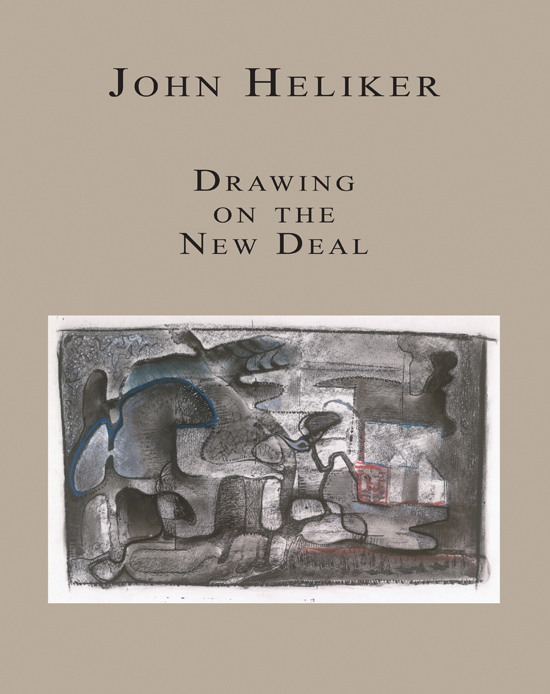
978-1-936205-32-5
John Heliker: Drawing on the New Deal marks the rediscovery of a remarkable and largely unknown body of early work by an eminent American artist. Heliker (1909-2000) developed a highly personal and expressive approach to drawing during the WPA years. His early drawings compare to his Social Realist contemporaries Ben Shahn and Philip Evergood. Heliker shared in their political activism and produced many anti-fascist cartoons for The New Masses, some represented here. During WWII and the immediate Postwar years, Heliker earned critical acclaim for his bold experimentations with biomorphic and architectonic abstractions. By the late 1950s and in subsequent decades, his style became more muted, and he achieved a tonalist manner of great poignancy. Heliker developed a nuanced, impressionistic painting style in response to abstract expressionism-an approach that characterized his mature style.Heliker earned the Prix de Rome, a Guggenheim fellowship, and three Ford Foundation purchase prizes, among other honors, including a full scale retrospective at the Whitney Museum of American Art (1968). He was connected with the abstract expressionist Philip Guston, who became a life-long friend. Heliker taught at Columbia University (1947-74) and later at the Art Students League of New York (1975-78). He co-founded the New York Studio School in 1965 (with fellow artists Philip Guston, Leland Bell and Mercedes Matter).Heliker was also associated with the composers: Carl Ruggles, John Cage, and Lou Harrison.He also created mask design for the dancer and choreographer, Merce Cunningham.
DAVID A LEWIS specializes in Modern art and has written about Dorothy Shakespear Pound, Leonard Baskin, and Michael (Corinne) West. JED PERL is the art critic for The New Republic. Among his books are Eyewitness, New Art City, and Antoine's Alphabet. He is currently working on the first full-length biography of Alexander Calder.
KEEPING EVEN
Sheila Sanderson
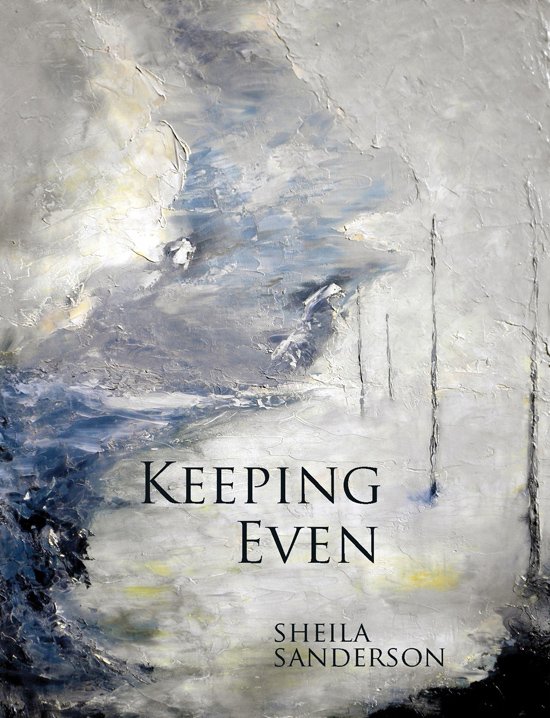
978-1-936205-42-4
Whether the scene happens to be the wildebeest migration trail through the Serengetti, or a pond in Kentucky "growing every minute greener," or a stand of saguaro in the low desert of Arizona, Sheila Sanderson's Keeping Even conveys a strong sense of place, of being grounded on " an actual, factual, earth."
"Sanderson understands that you can't get to the metaphysical without first experiencing and enduring the physical," says Alexander Long, author of Light Here, Light There and Still Life. "She straddles the known and unknown planes of existence buoyed by a voice that's at once ironic and sincere, in a word, genuine. Sanderson swirls her personal myth with Biblical myth to reveal the essential, but seldom revealed, truth that they're one and the same. Muezzins and hobos exist side-by-side in Sanderson's world . . . . Wherever we are, and whoever we're with, she reminds us-no, convinces us-that "the closing argument is faith."
To Sally Ball, authorof Annus Mirabilis, the poems in Keeping Even reveal a "reckless hopefulness." She says, "Sheila Sanderson's voice . . . will get in your head and stay there."
Keeping Even is "a brilliant book," says K. L. Cook, author of Love Songs for the Quarantined and Last Call: "written in a wondrous blend of the vernacular and the philosophical, the poems . . .glow with radiance and wit . . . . Sanderson beautifully meditates on the epiphanies of travel, the knotty loyalties of family and home, the bewilderment of grief, and the complex gratitude for being 'temporarily employed by the species.'"
The poems in Keeping Even call attention to the various balancing acts that living requires, to the desire to define and locate the center of gravity.
"Sheila Sanderson writes a mature and committed poetry-a poetry that cuts to the bone, a poetry committed to cherishing the elemental wonders surrounding her life. Sanderson pays close attention to nature and her appreciation is specific, fresh, and hard-won, for Sanderson is a poet who, through hands-on observation, realizes the ironies and inequities of experience. And so her vision is subtle, wry, and realistic. The experience of a Sanderson poem is always essential. Her voice is uniquely her own, and a reader will hear Biblical overlays at the edges, in her poetry's fierce music, in its gravity and concern. Sanderson commands a consistent and sophisticated syntax, and her voice, her style, support and include the contradictions of hope-which is where her poems brilliantly lead."-Christopher Buckley
SHEILA SANDERSON lives in the high desert mountains of Prescott, Arizona and teaches Arts & Letters Program at Prescott College. She serves as a poetry and creative nonfiction editor for Alligator Juniper.
THE KNIGHT'S TALE
Marc Guidry
Illustrations by Charles D. Jones

978-1-936205-23-3
The Knight's Tale breaks boundaries. It uncovers the dark heart of chivalric idealism, injects the political seriousness of epic into the timeless summer of romance, insists on a pagan outlook within a Christian culture, and draws compassion for female suffering from a man's world. Along with the exquisite anonymous poem Sir Gawain and the Green Knight, the Knight's Tale is the most intricately structured and stylistically pleasing of medieval English romances. For these reasons, it is worthy of its own edition, but what makes it particularly suitable to an illustrated edition is how its narration works by condensing actions and their effects into powerful images and figures. has, in fact, been illustrated many times, but never so thoroughly as in the current edition. Moreover, past illustrations have tended to romanticize or sentimentalize the story, eschewing its most violent and disturbing images. The illustrations in this edition attempt to recapture Chaucer's mature vision of the noble life, which refuses to deny the tragic aspects of the chivalric equation of love with war and war with honor. Past illustrations have also tended to adopt a Gothic idiom. The illustrations in our edition adopt a Classical Greek idiom drawn from the Parthenon frieze, Attic black- and red-figure pottery, and ancient Greek sculpture-an idiom suitable to the setting of the tale in legendary Athens and Thebes as well as to Chaucer's humanist impusle.If considering Theseus's prosecution of war as a civilizing force, one can point to the fact that he puts an end to Creon's "tirannye" (941), restoring the bodies of the desecrated dead to the Argive widows. However, if his objective in attacking Thebes is to avenge the widows on Creon, why does he destroy the city after he has already killed him and routed the Theban army, tearing down "wall, and sparre and rafter" (line 990)? The motive is hardly humanitarian, nor even strategic in the military sense since the Theban forces have already been defeated. Its only objective is pillage-to pay off the Athenian troops-and, of course, it is while ransacking the dead that they find Palamon and Arcite still alive among a pile of corpses, a detail unique to Chaucer's text.
While such a practice was endemic to chivalric warfare, it was difficult to contain once started, and it would inevitably produce results inimical to Theseus's stated purpose for going to war against Thebes, which was to right a wrong done to a group of helpless women. As Maurice Keen writes, the trouble with the practice of looting-as-pay was that to pay off soldiers in this way was not the same as to disband them. They had to be left at large, still armed with equipment that was their own, beyond control; and so whole provinces were subjected to the indiscriminate pillaging of soldiery that sought to claim a share in chivalry but whose manner of living was the antithesis of what chivalry stood for, the protection of the poor, the fatherless and the widow.
The Knight's Tale poses the pivotal question about war: Is there such a thing as civilized warfare, as war fought for a just cause in a controlled manner as a means of restoring order to society, or do all wars inevitably lead to acts of savagery and excess that make a mockery of policy?35 Ancient Thebes is the story of a sustained, sordid, brutal, and self-indulgent lust for power and pleasure eventuating in spectacular violence-Cadmus and the dragon-tooth warriors, Oedipus's primal crimes against nature, Eteocles and Polynices' impiety and fratricidal warfare, Creon's desecration of his nephew's corpse and subsequent murder of his niece Antigone. The idea of a moderate use of force to serve the common good is alien to the Theban legend. Statius considers the possibility of a good war by inserting the Athenian warlord Theseus into the myth of Thebes.
Theseus brings peace to Thebes and, in Statius's version of events, saves Antigone, but only after an unforgettable orgy of death has occurred. As discussed above, Chaucer returned to Statius's brooding treatment of the Theban material in order to foreground it. He rereads the Teseida through the lens of the Thebaid, turning it from a conventional love story into a philosophical reflection on the nature of love, war, and governance-both earthly and cosmic. Indeed, it becomes a kind of theodicy, asking why humans must suffer so much and whether there is a benevolent order that transcends the individual ills of human experience, providing an origin for temporal governance. In this vein, Chaucer presents the stadium Theseus builds to hold the tournament as a theatrum mundi, a microcosmic space in which Theseus will try to civilize the unruly dispute between Palamon and Arcite, itself symbolic of the dynastic rivalry between Polynices and Eteocles. 36
Ominously, there is nothing to stop Theseus's men from just such rapine, as he "dide with al the contree as hym leste" (line 1004). For Chaucer, it seems it is not justice but fortune that decides the outcome of war. The eldest Argive widow reminds Theseus of the role of "Fortune" in war, and Chaucer returns to the idea of the uncertainty of military ventures in the temple of Mars murals, where an enthroned "Conquest" (line 2028) is depicted with the sharp sword of Damocles hanging over his head by the thinnest of threads. Perhaps Theseus learns this lesson, as he moves steadily away from militarism in Chaucer's narrative, changing the rules of the tournament to prevent mortal combat and ending the strife with Thebes through the diplomacy of the parliament. Yet, even in the mock battle of the tournament, death cannot be prevented, despite his best efforts.
Is Chaucer suggesting that the prospect of limited warfare for some greater purpose (in this case the eventual pacification of Thebes) is human folly? Chaucer's
CHARLES D. JONES, Regents Professor of Art, is the director and master printer of the LaNana Creek Press at Stephen F. Austin State University in Nacogdoches, Texas and has taught printmaking since 1971.
MARC GUIDRY received his PhD from Louisiana State University. He has published essays on Chaucer in The Chaucer Review and Medieval Rhetoric, a Routledge casebook.
MOVING THE PIANO
Faith Shearin
.jpg)
978-1-936205-40-0
In the title poem of Shearin's Moving The Piano, a piano hangs above a city street, bundled and displaced, awkward when it should be elegant, similar to her childhood of damaged Christmas trees, misunderstood pets, and untended lawns.
The piano is temporarily displaced, seen differently because it is lifted away from its ordinary surroundings: suspended above the burdens of the earth. The poems in this collection also seek to hold objects and emotions aloft, to allow them to dangle above the usual landscape, allowing the reader a new vantage point.
The book contains many poems that explore the particulars of life on the island of Kitty Hawk where she was a child; they pay attention to untended lawns, sunburns, turtles, motherhood, dead pets, and wilted Christmas trees. One very brief poem explains how to live without money. The collection pays notice to foxes and jellyfish, to the places where she can hear the ocean; it ponders aging and money and motherhood. Shearin says of the piano: "We cannot/ turn away from its startling/ moment of freedom, its perilous fling/ before it returns to the burdens of this earth." Her poems capture that perilous fling.
Her first collection, The Owl Question, won the May Swenson Award and the poems in her second, The Empty House, helped he rwin a grant from The National Endowment for the Arts. Her work has appeared regularly in Ploughshares, The Sun, and North American Review and has been read aloud by Garrison Keillor on his show The Writer's Almanac. Recent work also appears in the Autumn House Anthology of Contemporary American Poets.
The poems in Moving the Piano were written over a period of three years, on the island of Kitty Hawk, with the help of grants from the NEA and the Barbara Deming Memorial Fund. They contain the images and emotions and ideas that she finds most compelling and moving;
FAITH SHEARIN'S previous books of poetry are The Owl Question (2002) and The Empty House (2008). She has received the May Swenson Award and awards from the Fine Arts Work Center in Provincetown, the National Endowment for the Arts, among others.
NACOGDOCHES NOW AND THEN
Photography by Christopher Talbot Introduction by David A. Lewis
.jpg)
978-1-936205-03-5
Nacogdoches Now and Then documents a project taken on by Christopher Talbot and his photography class from Stephen F. Austin State University. The project involved researching historic photographs of Nacogdoches and revisiting the precise locations. The project had two objectives: 1) make art out of history, and 2) bring history alive through art. Using source photographs dating from 1882 to the mid-20th Century, Talbot and his students had to become researchers and explorers in order to realize their objectives. Readers of this book are treated to a blending of Nacogdoches' past with present, and, using it as a model, may continue the tradition by juxtaposing their own photographic documents against time's transformation.CHRISTOPHER TALBOT is an Assistant Professor of Art at Stephen F. Austin State University. He holds a BFA degree in Photography from Brigham Young University and a MFA in Photography and Digital Media from the University of Houston. DAVID A. LEWIS holds a BA in Art and Philosophy (Cum Laude) from the University of Southern Indiana, and both MA and Ph.D. degrees in Art History from Indiana University, Bloomington. He is an Associate Professor of Art History at Stephen F. Austin State University.
SHERBURNE
R.T. Smith
.jpg)
978-1-936205-44-8
R. T. Smith's Sherburne chronicles the title family's encounters with ruthlessness over several generations. The patriarch discovers himself when he encounters Sherman's horse soldiers in 1864 Georgia, and his son, working in law enforcement in the Virginia Blue Ridge, finds himself struggling with moral issues in a harsh landscape. As practitioners and victims of violence, the Sherburne family makes an apt portrait of Smith's conviction that even those who resort to force on behalf of their community must bear the responsibility and carry the scars."Ranging through time from the Civil War to the present, this intricate and exquisitely written collection further confirms that R. T. Smith is one of America's best writers. Sherburne is a magnificant acheivement."-Ron Rash
R. T. SMITH is Writer-in-Residence at Washington and Lee University, where he edits Shenandoah. His stories have appeared in the Pushcart Prize Anthology, and five volumes of New Stories from the South. His most recent book of poetry, Outlaw Style, received the Library of Virginia Book of the Year Award in 2008.
Selected poetry collections of R.T. Smith Outlaw Style: Poems (Arkansas Poetry Series, 2007) The Hollow Log Lounge (University of Illinois Press, 2003). Winner of the 2004 Maurice English Poetry Award. Brightwood (Louisiana State University Press, 2003) Messenger (Louisiana State University Press, 2001). Winner of the Library of Virginia Poetry Prize. Split the Lark: Selected Poems (1999) Trespasser (1996). Hunter-Gatherer (Livingston University Press, 1996) The Cardinal Heart (1991). Nominated for the Pulitzer Prize for Poetry. From the High Dive (1983)
Fiction Collections: Faith: Stories (Black Belt Press, 1995) Uke Rivers Delivers: Stories (Yellow Shoe Press, 2006) The Calaboose Epistles (Iris Press, 2009)
A Short Bestiary of Love and Madness
George Looney
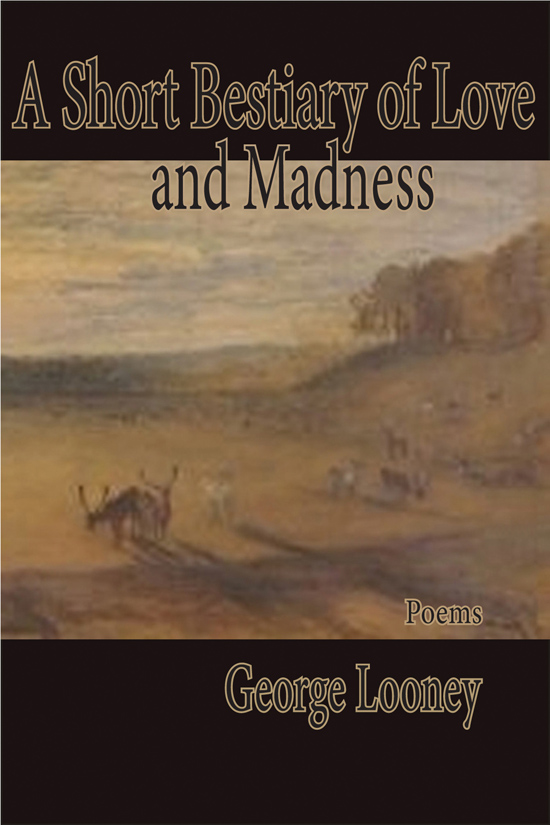
978-1-936205-34-9
A SHORT BESTIARY OF LOVE AND MADNESS, POEMS THAT GIVE VOICE TO THE ANIMAL IN US ALL In verse and in prose, George Looney's fifth book of poetry, A Short Bestiary of Love and Madness, delves into the worlds of birds and mammals, fish and insects, looking for ways to describe and maybe even understand the various madnesses that love brings. In the lives of the beasts we find find much hard evidence of loss and despair, but these fables and parables offer, along the way, absolution and, yes, even salvation, of a sort.
"George Looney's poetry," novelist and poet Laura Kasischke writes, "resonates at the level of myth and history, evoking a kind of ancient music alongside the details of our contemporary lives the way weather and the human psyche join to make a dream. This is an important and impressive new collection by one of our most interesting poets." The poems in this collection create a realm where myth and history come together to form a natural world imbued with meaning, one that allows for the possibility of finding, carved in rock, "a figure that could be divine" (as one of the poems puts it). In this evocative collection, as "Formed of Burning and Song" puts it, readers will witness a passionate language "etching / the elaborate form of longing in the earth."
George Looney's books include The Precarious Rhetoric of Angels (2005 White Pine Press Poetry Prize), Attendant Ghosts (Cleveland State University Press, 2000), Animals Housed in the Pleasure of Flesh (1995 Bluestem Award), Hymn of Ash (the 2007 Elixir Press Fiction Chapbook Award), a new book of poetry, Open Between Us (Turning Point Press, 2010), and the forthcoming A History of What Music Can Do (Truman State University Press, 2012).
His work has earned fellowships from the National Endowment for the Arts, the Ohio Arts Council, and the Pennsylvania Council on the Arts, as well as awards from such literary journals as The Missouri Review, Zone 3, New Letters, and The Literary Review. He is Chair of the BFA in Creative Writing Program at Penn State Erie (a program he founded), Editor-in-Chief of the international literary journal Lake Effect, Translation Editor of Mid-American Review (where he was once Editor-in-Chief), and Co-Director (and Co-Founder) of the Chautauqua Writers' Festival. He earned his M.F.A. in Creative Writing at Bowling Green State
SO THERE!
Nicole Louise Reid
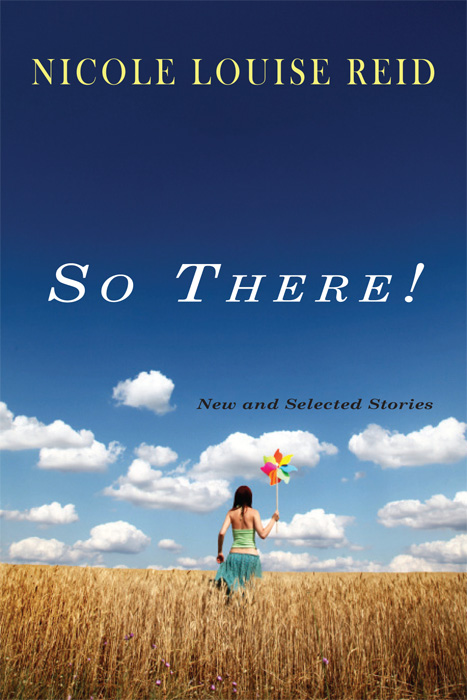
978-1-936205-45-5
With the graceful lyricism of a musician's ear, the stories of So There! inhabit the quiet spaces of heartache and the loud spaces of rage. Their landscapes harken back to the South of Reid's first novel, In the Breeze of Passing Things, and form their own kind of topography, the human heart and its many urges. Within the world of this collection, girls and women sidle the precipice of new lives and new selves.
In "If You Must Know," a young woman serves as host to a cicada and tries to recreate the bliss of her first sexual experience, the very moment when the insect chose to burrow into her. "Pearl in a Pocket" is the story of young teen Vyla-one of thirteen sisters, some living, more miscarried-who discovers how powerless love can be. "So There," a 15-year old girl recalls the rhythm of nights her father swung her around the Black Diamond Lounge while her mother stole dances with anyone and everyone else.
The girls and women of these stories stand at the edge of rebirth undeniably aware that who they are-their shape, their class, their family, their brand of love or crazy-makes them far more complicated than the world will allow. They are brave and terrified, isolated and enveloped; they are dead and bleed to live. And all seem to stand with hands on hips, defiant in that knowledge, even perhaps eating it up.
NICOLE LOUISE REID is the author of the novel In the Breeze of Passing Things. Her award-winning short stories have appeared in The Southern Review, Other Voices, Quarterly West, Black Warrior Review, and Meridian. A recipient of the Willamette Award in Fiction, she teaches creative writing at the University of Southern Indiana. She lives in Newburgh, Indiana.
THOSE LIKE US
Christopher Lowe
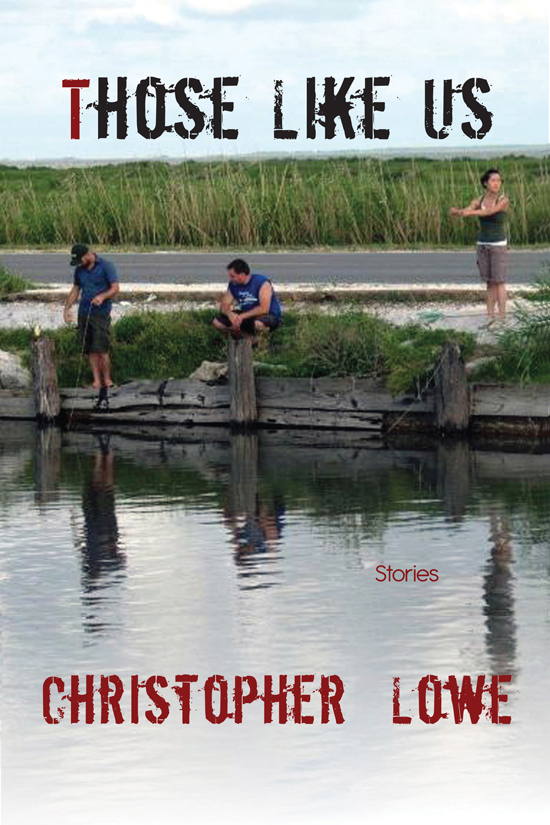
978-1-936205-38-7
Those Like Us presents characters struggling against the weight of memory. The collection opens with the story of a teenager who connects with his dying father through the football rivalry that has always divided their family. In "Dunn's River Falls," a young veteran is thrust back into a world of chaos when his wife suffers a terrible accident on their honeymoon. "Variations on a Line from Joe Namath" centers on a high school football coach trying to carve out an identity for himself as he struggles with the legacy of his father and his own past as an athlete. Coaches and linemen, bartenders and drunks, tour guides and EMTs, the characters in these stories are obsessed and adrift.
CHRISTOPHER LOWE'S short fiction and poetry have appeared widely in journals and magazines including Third Coast, Bellevue Literary Review, and New Plains Review. Originally from Mississippi, he lives with his wife and daughter in Lake Charles, LA where he teaches at McNeese State University.
WIDOWS AND ORPHANS FUND
Alan Elyshevitz
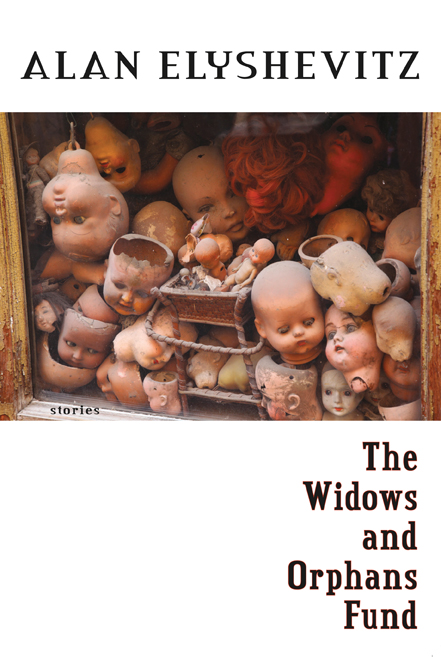
978-1-936205-46-2
The Widows and Orphans Fund is a collection of stories that presents a cross-section of modern American society through diverse characters in disparate locales. The "heroes" of these tales are male and female, young and old, straight and gay, Jewish and gentile, Caucasian, Latino, and Native American. They struggle in their relationships with lovers, family, friends, and co-workers. They inhabit the cities, suburbs, mountains, forests, and deserts of a multifaceted country that seems simultaneously real and imaginary. In essence, the landscape of this collection is a stage set where characters are subjected to dramatic conflicts between their sometimes contradictory desires as they grope for their independent identities yet hunger for connections to other human beings.
This characteristically American dilemma, driven by a cultural myth of the sovereignty of the individual, is illuminated by these characters' personal stories that, for some, culminate in physical, emotional, or spiritual isolation, while others achieve peace within themselves or communion with others. In the end, the reader comes away with a greater awareness of, and feeling for, a wide variety of experiences related to a fundamental human theme.
ALAN ELYSHEVITZ is a short story writer and poet who lives in East Norriton, PA. His fiction has received awards from Antietam Review, The Cream City Review, Pebble Lake Review, Briar Cliff Review, and Yemassee. He is a two-time recipient of a fellowship in fiction writing from the Pennsylvania Council on the Arts.